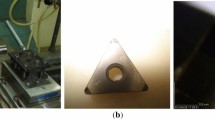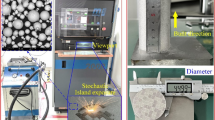Abstract
In this study, indentation experiments were conducted on high-strength elastic alloy 3J33B material with a Berkovich indenter to study the elastic recovery of material. The experimental data showed that the load and material properties influence elastic recovery ratio of material. The functional expressions of elastic recovery ratio and load were established by regression analysis of experimental data. Therefore, the depths of elastic recovery of 3J33B can be controlled by adjusting the indentation load. Alloy 3J33B has the property of high elastic energy, so it is easy to produce large elastic recovery in the machining. Based on the functional expressions of elastic recovery ratio and load, it can be obtained that the relationships among the elastic recovery ratio of the machined surface, the yield strength of the material, the clearance angle, the average sliding friction coefficient between the tool and the workpiece, the wear width of the flank face and the cutting width. Then, the critical values of tool wear at different clearance angles can be obtained when the yield strength of material, the average sliding friction coefficient between the tool and the workpiece and the cutting width are known. Then, a group of micro milling experiments were conducted on alloy 3J33B using several single-edge micro milling cutters. Finally, it can be obtained that the clearance angle of cutting tool should not be more than 34° in micro cutting in order to reduce the tool wear.
















Similar content being viewed by others
References
Lu XH, Jia ZY, Wang H, Wang XX, Si LK, Gao LS (2016) Stability analysis for micro-milling nickel-based superalloy process. Int J Adv Manuf Technol 86(9):2503–2515. https://doi.org/10.1007/s00170-016-8352-7
Wang SJ, To S, Cheung CF (2012) Effect of workpiece material on surface roughness in ultraprecision raster milling. Mater Manuf Process 27(10):1022–1028. https://doi.org/10.1080/10426914.2011.654165
Lawn BR, Howes VR (1981) Elastic recovery at hardness indentations. J Mater Sci 16(10):2745–2752. https://doi.org/10.1007/BF02402837
Jardret V, Zahouani H, Loubet JL, Mathia TG (1998) Understanding and quantification of elastic and plastic deformation during a scratch test. Wear 218(1):8–14. https://doi.org/10.1016/S0043-1648(98)00200-2
Nayebi A, Abdi RE, Bartier O, Mauvoisin G (2002) New procedure to determine steel mechanical parameters from the spherical indentation technique. Mech Mater 34(4):243–254. https://doi.org/10.1016/S0167-6636(02)00113-8
Gong J, Miao HZ, Peng ZJ (2004) Analysis of the nanoindentation data measured with a Berkovich indenter for brittle materials: effect of the residual contact stress. Acta Mater 52(3):785–793. https://doi.org/10.1016/j.actamat.2003.10.013
Peng ZJ, Wen T, Gong JH, Wang CB, Fu ZQ, Mia HZ (2011) Relationship between the ratio of Young’s modulus to hardness and the elastic recovery of nanoindentation. Key Eng Mater 492:5–8. https://doi.org/10.4028/www.scientific.net/KEM.492.5
Hong X (1990) Wear behaviour and wear mechanism of ceramic tools in machining hardened alloy steel. Wear 139(2):439–451
Camara MA, Campos Rubio JC, Abrao AM, Davim JP (2012) State of the art on micromilling of materials, a review. J Mater Sci Technol 28(8):673–685. https://doi.org/10.1016/S1005-0302(12)60115-7
Tansel IN, Arkan TT, Bao WY, Mahendrakar N, Shisler B, Smith D, McCool M (2000) Tool wear estimation in micro-machining. Part 1: tool usage-cutting force relationship. Int J Mach Tool Manu 40(4):599–608. https://doi.org/10.1016/S0890-6955(99)00073-5
Tansel IN, Arkan TT, Bao WY, Mahendrakar N, Shisler B, Smith D, McCool M (2000) Tool wear estimation in micro-machining. Part 2: neural-network-based periodic inspector for non metals. Int J Mach Tool Manu 40(4):609–620. https://doi.org/10.1016/S0890-6955(99)00074-7
Rahman M, Kumar AS, Prakash JRS (2001) Micro milling of pure copper. J Mater Process Technol 116(1):39–43. https://doi.org/10.1016/S0924-0136(01)00848-2
Zhang XW, Yu TB, Zhao J (2020) Surface generation modeling of micro milling process with stochastic tool wear. Precis Eng 61:170–181. https://doi.org/10.1016/j.precisioneng.2019.10.015
Liu X, Devor RE, Kapoor SG, Ehman KF (2004) The mechanics of machining at the micro scale: assessment of the current state of the science. J Manuf Sci E 126(4):666–678. https://doi.org/10.1115/1.1813469
Kim JD, Kim DS (1995) Theoretical analysis of micro-cutting characteristics in ultra-precision machining. J Mater Process Technol 49(3-4):387–398. https://doi.org/10.1016/0924-0136(94)01345-2
Zhou YD, Tian YL, Jing XB, Ehmann KF (2017) A novel instantaneous uncut chip thickness model for mechanistic cutting force model in micro-end-milling. Int J Adv Manuf Technol 93(5):2305–2319. https://doi.org/10.1007/s00170-017-0638-x
Yan MF, Wu YQ, Wang Y, Liu RL (2009) Nanocrystallization of alloy 3J33 by a complex thermomechanical treatment process. Mat Sci Eng A 509(1-2):41–45. https://doi.org/10.1016/j.msea.2009.01.004
Yao Y, Zhu HT, Huang CZ, Wang J, Zhang P, Yao P (2019) Investigation on chip formation and surface integrity in micro end milling of maraging steel. Int J Adv Manuf Technol 102(5):1973–1984. https://doi.org/10.1007/s00170-018-03219-3
Yao Y, Zhu HT, Huang CZ, Wang J, Zhang P, Yao P (2019) On the relations between the specific cutting energy and surface generation in micro-milling of maraging steel. Int J Adv Manuf Technol 104(1):585–598. https://doi.org/10.1007/s00170-019-03911-y
Zhao M, Ji X, Liang SY (2019) Force prediction in micro-grinding maraging steel 3J33B considering the crystallographic orientation and phase transformation. J Adv Manuf Technol 103(5):2821–2836. https://doi.org/10.1007/s00170-019-03724-z
Lucca DA, Rhorer RL, Komanduri R (1991) Energy dissipation in the ultraprecision machining of copper. CIRP Ann 40(1):69–72. https://doi.org/10.1016/S0007-8506(07)61936-2
Oliver W, Pharr GM (1992) An improved technique for determining hardness and elastic modulus using load and displacement sensing indentation experiments. J Mater Res 7(6):1564–1583. https://doi.org/10.1557/JMR.1992.1564
Oliver W, Pharr GM (2004) Measurement of hardness and elastic modulus by instrumented indentation: advances in understanding and refinements to methodology. J Mater Res 19(1):3–20. https://doi.org/10.1557/jmr.2004.0002
Grzesik W, Rech J, Żak K (2014) Determination of friction in metal cutting with tool wear and flank face effects. Wear 317:8–16. https://doi.org/10.1016/j.wear.2014.05.003
Funding
This work is supported by Major Program of Shandong Province Natural Science Foundation (ZR2018ZA0401) and National Natural Science Foundation of China (U1708256).
Author information
Authors and Affiliations
Corresponding authors
Ethics declarations
All authors participated in the compilation of this manuscript and consented to the final version of the submitted manuscript. All authors assured that the manuscript was the authors’ original work, and this manuscript had not been published in advance and was not being considered for publication elsewhere. All authors consented to publish this manuscript in “The International Journal of Advanced Manufacturing Technology.” All authors declare that there are no competing interests. The data sets supporting the results of this article are included within the article and its additional files.
Additional information
Publisher’s note
Springer Nature remains neutral with regard to jurisdictional claims in published maps and institutional affiliations.
Rights and permissions
About this article
Cite this article
Zhang, P., Huang, C., Zhu, H. et al. The research of tool wear criterion in micro cutting using the elastic recovery ratio of high-strength elastic alloy 3J33B. Int J Adv Manuf Technol 114, 1767–1776 (2021). https://doi.org/10.1007/s00170-021-06937-3
Received:
Accepted:
Published:
Issue Date:
DOI: https://doi.org/10.1007/s00170-021-06937-3




